Racism, Anti-Racism, and Employment Discrimination Essay
VerifiedAdded on 2023/04/11
|11
|2777
|126
Essay
AI Summary
This essay delves into the multifaceted concepts of racism and anti-racism, examining their historical context and societal impact. The first part defines racism as a belief in racial superiority and anti-racism as the active effort to dismantle racial discrimination. The essay discusses the social construction of race, distinguishing it from ethnicity, and highlights the role of power dynamics, ignorance, and fear in perpetuating racism. The second part focuses on racism in employment, exploring its manifestations through discrimination, microaggressions, and unequal opportunities. The essay includes a personal experience of racial bias and suggests organizational strategies for combating racism, such as training, policy reviews, creating safe spaces, and raising awareness of relevant laws. The essay underscores the importance of proactive measures to foster diversity, inclusion, and equitable workplaces.
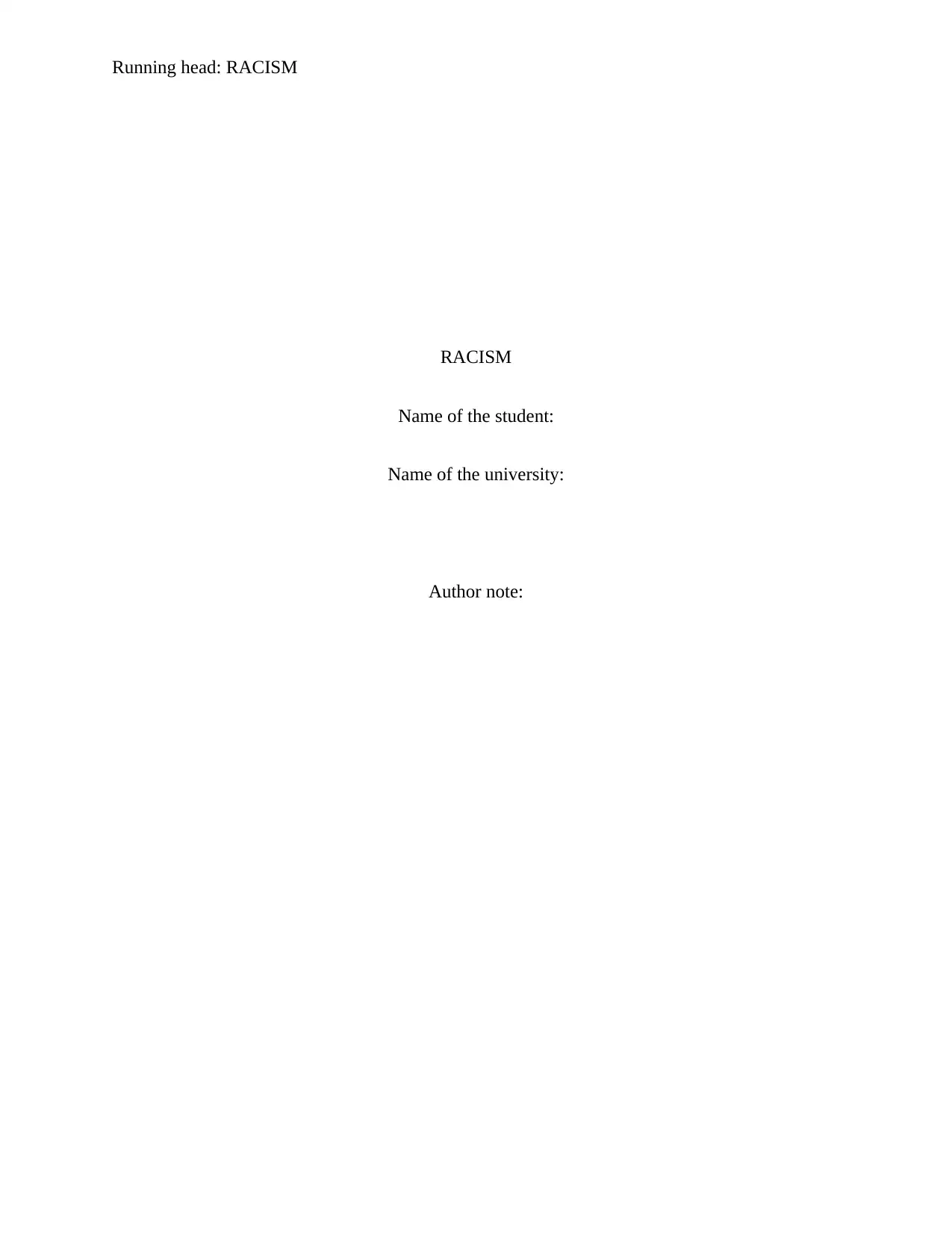
Running head: RACISM
RACISM
Name of the student:
Name of the university:
Author note:
RACISM
Name of the student:
Name of the university:
Author note:
Paraphrase This Document
Need a fresh take? Get an instant paraphrase of this document with our AI Paraphraser
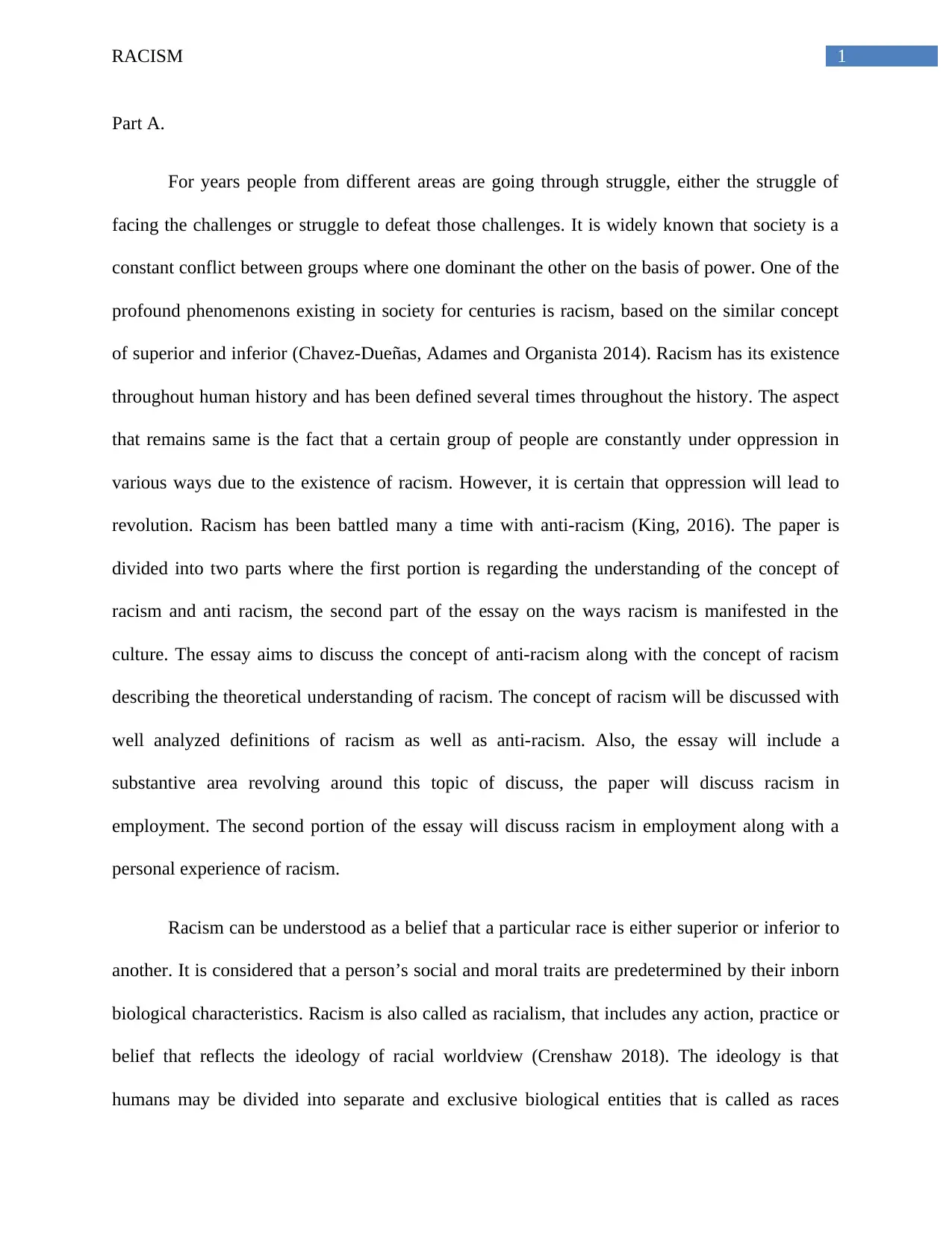
1RACISM
Part A.
For years people from different areas are going through struggle, either the struggle of
facing the challenges or struggle to defeat those challenges. It is widely known that society is a
constant conflict between groups where one dominant the other on the basis of power. One of the
profound phenomenons existing in society for centuries is racism, based on the similar concept
of superior and inferior (Chavez-Dueñas, Adames and Organista 2014). Racism has its existence
throughout human history and has been defined several times throughout the history. The aspect
that remains same is the fact that a certain group of people are constantly under oppression in
various ways due to the existence of racism. However, it is certain that oppression will lead to
revolution. Racism has been battled many a time with anti-racism (King, 2016). The paper is
divided into two parts where the first portion is regarding the understanding of the concept of
racism and anti racism, the second part of the essay on the ways racism is manifested in the
culture. The essay aims to discuss the concept of anti-racism along with the concept of racism
describing the theoretical understanding of racism. The concept of racism will be discussed with
well analyzed definitions of racism as well as anti-racism. Also, the essay will include a
substantive area revolving around this topic of discuss, the paper will discuss racism in
employment. The second portion of the essay will discuss racism in employment along with a
personal experience of racism.
Racism can be understood as a belief that a particular race is either superior or inferior to
another. It is considered that a person’s social and moral traits are predetermined by their inborn
biological characteristics. Racism is also called as racialism, that includes any action, practice or
belief that reflects the ideology of racial worldview (Crenshaw 2018). The ideology is that
humans may be divided into separate and exclusive biological entities that is called as races
Part A.
For years people from different areas are going through struggle, either the struggle of
facing the challenges or struggle to defeat those challenges. It is widely known that society is a
constant conflict between groups where one dominant the other on the basis of power. One of the
profound phenomenons existing in society for centuries is racism, based on the similar concept
of superior and inferior (Chavez-Dueñas, Adames and Organista 2014). Racism has its existence
throughout human history and has been defined several times throughout the history. The aspect
that remains same is the fact that a certain group of people are constantly under oppression in
various ways due to the existence of racism. However, it is certain that oppression will lead to
revolution. Racism has been battled many a time with anti-racism (King, 2016). The paper is
divided into two parts where the first portion is regarding the understanding of the concept of
racism and anti racism, the second part of the essay on the ways racism is manifested in the
culture. The essay aims to discuss the concept of anti-racism along with the concept of racism
describing the theoretical understanding of racism. The concept of racism will be discussed with
well analyzed definitions of racism as well as anti-racism. Also, the essay will include a
substantive area revolving around this topic of discuss, the paper will discuss racism in
employment. The second portion of the essay will discuss racism in employment along with a
personal experience of racism.
Racism can be understood as a belief that a particular race is either superior or inferior to
another. It is considered that a person’s social and moral traits are predetermined by their inborn
biological characteristics. Racism is also called as racialism, that includes any action, practice or
belief that reflects the ideology of racial worldview (Crenshaw 2018). The ideology is that
humans may be divided into separate and exclusive biological entities that is called as races
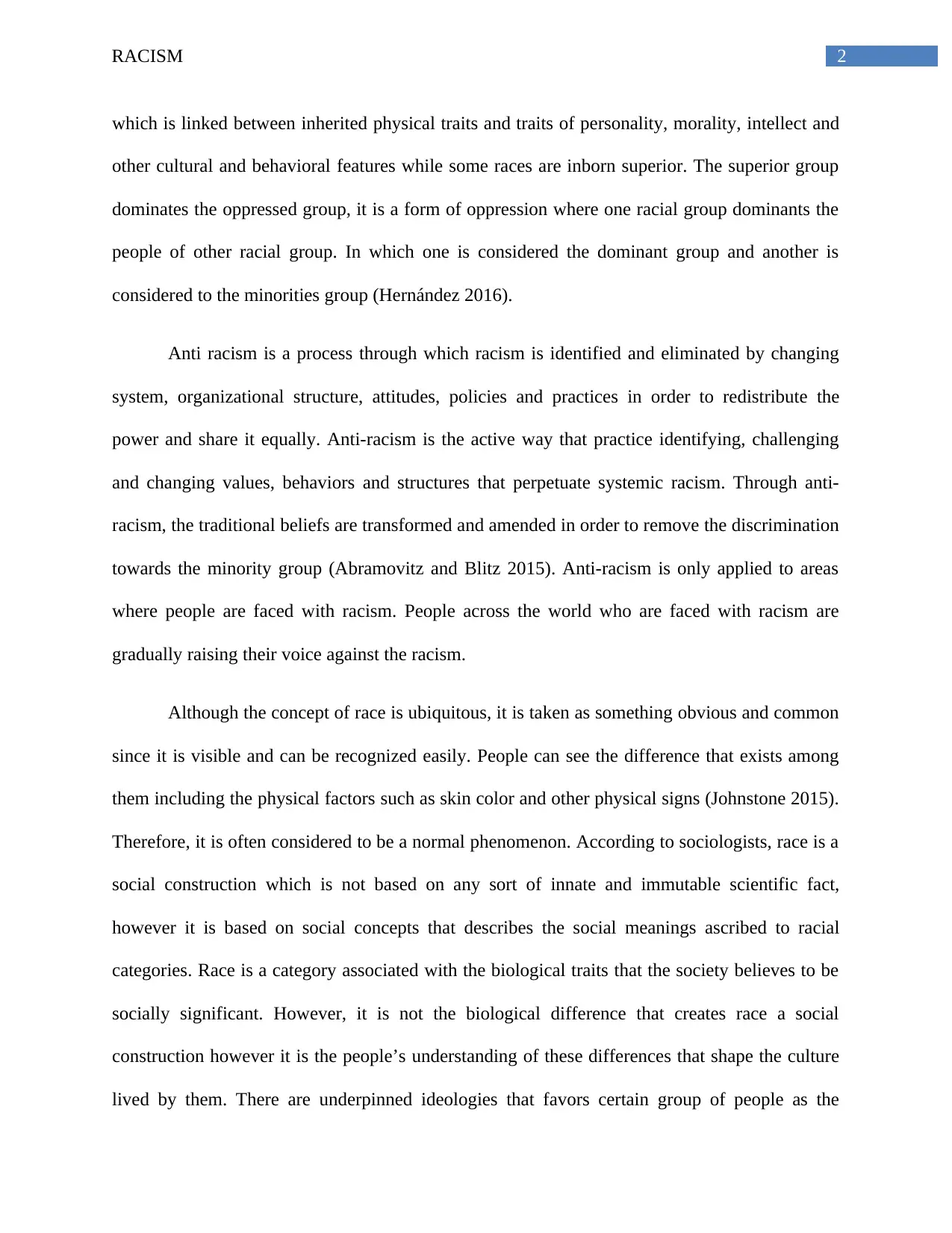
2RACISM
which is linked between inherited physical traits and traits of personality, morality, intellect and
other cultural and behavioral features while some races are inborn superior. The superior group
dominates the oppressed group, it is a form of oppression where one racial group dominants the
people of other racial group. In which one is considered the dominant group and another is
considered to the minorities group (Hernández 2016).
Anti racism is a process through which racism is identified and eliminated by changing
system, organizational structure, attitudes, policies and practices in order to redistribute the
power and share it equally. Anti-racism is the active way that practice identifying, challenging
and changing values, behaviors and structures that perpetuate systemic racism. Through anti-
racism, the traditional beliefs are transformed and amended in order to remove the discrimination
towards the minority group (Abramovitz and Blitz 2015). Anti-racism is only applied to areas
where people are faced with racism. People across the world who are faced with racism are
gradually raising their voice against the racism.
Although the concept of race is ubiquitous, it is taken as something obvious and common
since it is visible and can be recognized easily. People can see the difference that exists among
them including the physical factors such as skin color and other physical signs (Johnstone 2015).
Therefore, it is often considered to be a normal phenomenon. According to sociologists, race is a
social construction which is not based on any sort of innate and immutable scientific fact,
however it is based on social concepts that describes the social meanings ascribed to racial
categories. Race is a category associated with the biological traits that the society believes to be
socially significant. However, it is not the biological difference that creates race a social
construction however it is the people’s understanding of these differences that shape the culture
lived by them. There are underpinned ideologies that favors certain group of people as the
which is linked between inherited physical traits and traits of personality, morality, intellect and
other cultural and behavioral features while some races are inborn superior. The superior group
dominates the oppressed group, it is a form of oppression where one racial group dominants the
people of other racial group. In which one is considered the dominant group and another is
considered to the minorities group (Hernández 2016).
Anti racism is a process through which racism is identified and eliminated by changing
system, organizational structure, attitudes, policies and practices in order to redistribute the
power and share it equally. Anti-racism is the active way that practice identifying, challenging
and changing values, behaviors and structures that perpetuate systemic racism. Through anti-
racism, the traditional beliefs are transformed and amended in order to remove the discrimination
towards the minority group (Abramovitz and Blitz 2015). Anti-racism is only applied to areas
where people are faced with racism. People across the world who are faced with racism are
gradually raising their voice against the racism.
Although the concept of race is ubiquitous, it is taken as something obvious and common
since it is visible and can be recognized easily. People can see the difference that exists among
them including the physical factors such as skin color and other physical signs (Johnstone 2015).
Therefore, it is often considered to be a normal phenomenon. According to sociologists, race is a
social construction which is not based on any sort of innate and immutable scientific fact,
however it is based on social concepts that describes the social meanings ascribed to racial
categories. Race is a category associated with the biological traits that the society believes to be
socially significant. However, it is not the biological difference that creates race a social
construction however it is the people’s understanding of these differences that shape the culture
lived by them. There are underpinned ideologies that favors certain group of people as the
⊘ This is a preview!⊘
Do you want full access?
Subscribe today to unlock all pages.

Trusted by 1+ million students worldwide
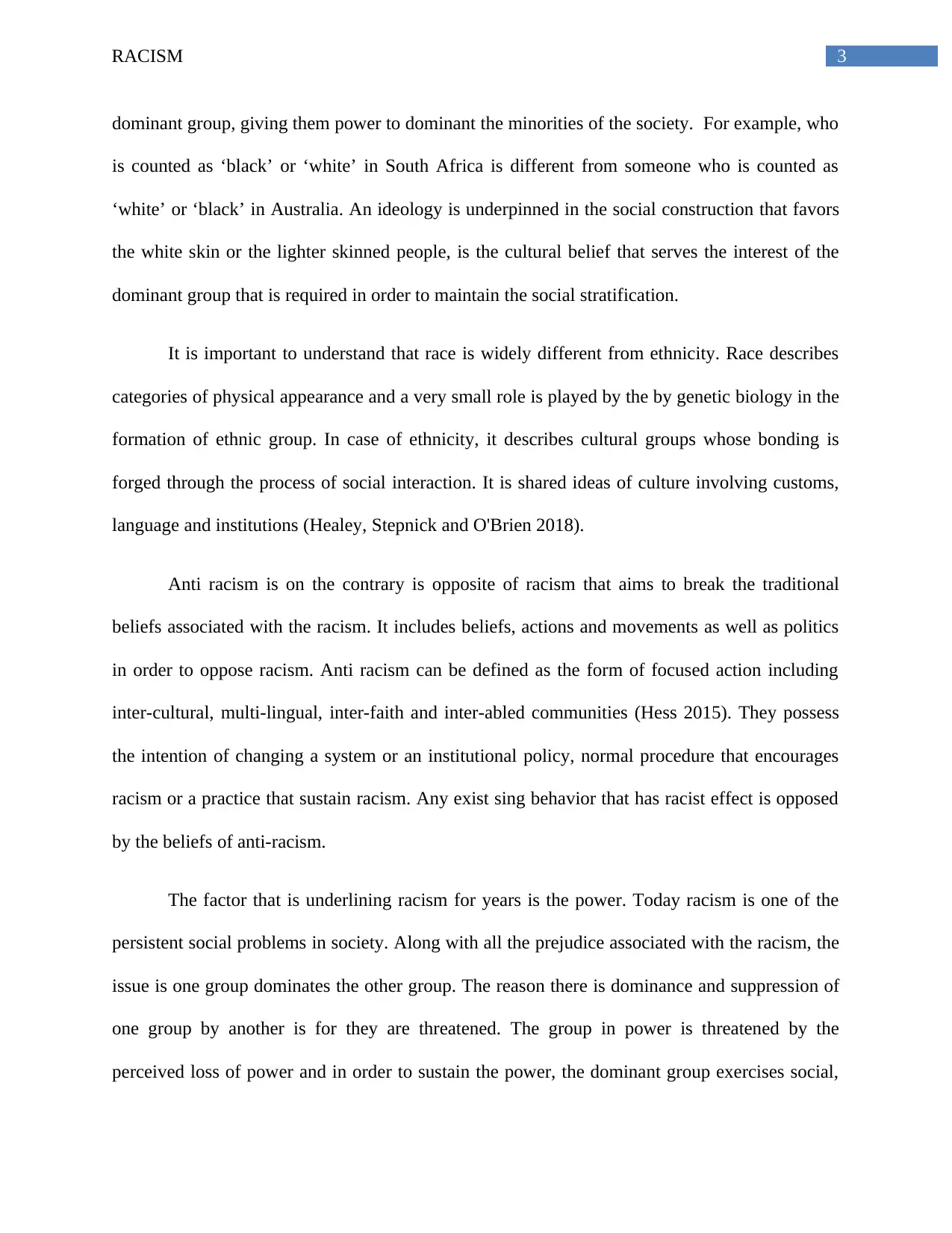
3RACISM
dominant group, giving them power to dominant the minorities of the society. For example, who
is counted as ‘black’ or ‘white’ in South Africa is different from someone who is counted as
‘white’ or ‘black’ in Australia. An ideology is underpinned in the social construction that favors
the white skin or the lighter skinned people, is the cultural belief that serves the interest of the
dominant group that is required in order to maintain the social stratification.
It is important to understand that race is widely different from ethnicity. Race describes
categories of physical appearance and a very small role is played by the by genetic biology in the
formation of ethnic group. In case of ethnicity, it describes cultural groups whose bonding is
forged through the process of social interaction. It is shared ideas of culture involving customs,
language and institutions (Healey, Stepnick and O'Brien 2018).
Anti racism is on the contrary is opposite of racism that aims to break the traditional
beliefs associated with the racism. It includes beliefs, actions and movements as well as politics
in order to oppose racism. Anti racism can be defined as the form of focused action including
inter-cultural, multi-lingual, inter-faith and inter-abled communities (Hess 2015). They possess
the intention of changing a system or an institutional policy, normal procedure that encourages
racism or a practice that sustain racism. Any exist sing behavior that has racist effect is opposed
by the beliefs of anti-racism.
The factor that is underlining racism for years is the power. Today racism is one of the
persistent social problems in society. Along with all the prejudice associated with the racism, the
issue is one group dominates the other group. The reason there is dominance and suppression of
one group by another is for they are threatened. The group in power is threatened by the
perceived loss of power and in order to sustain the power, the dominant group exercises social,
dominant group, giving them power to dominant the minorities of the society. For example, who
is counted as ‘black’ or ‘white’ in South Africa is different from someone who is counted as
‘white’ or ‘black’ in Australia. An ideology is underpinned in the social construction that favors
the white skin or the lighter skinned people, is the cultural belief that serves the interest of the
dominant group that is required in order to maintain the social stratification.
It is important to understand that race is widely different from ethnicity. Race describes
categories of physical appearance and a very small role is played by the by genetic biology in the
formation of ethnic group. In case of ethnicity, it describes cultural groups whose bonding is
forged through the process of social interaction. It is shared ideas of culture involving customs,
language and institutions (Healey, Stepnick and O'Brien 2018).
Anti racism is on the contrary is opposite of racism that aims to break the traditional
beliefs associated with the racism. It includes beliefs, actions and movements as well as politics
in order to oppose racism. Anti racism can be defined as the form of focused action including
inter-cultural, multi-lingual, inter-faith and inter-abled communities (Hess 2015). They possess
the intention of changing a system or an institutional policy, normal procedure that encourages
racism or a practice that sustain racism. Any exist sing behavior that has racist effect is opposed
by the beliefs of anti-racism.
The factor that is underlining racism for years is the power. Today racism is one of the
persistent social problems in society. Along with all the prejudice associated with the racism, the
issue is one group dominates the other group. The reason there is dominance and suppression of
one group by another is for they are threatened. The group in power is threatened by the
perceived loss of power and in order to sustain the power, the dominant group exercises social,
Paraphrase This Document
Need a fresh take? Get an instant paraphrase of this document with our AI Paraphraser

4RACISM
economic and political muscles against the other group (Haavisto 2019). The social advantages
for years cannot be imagined to be lost by social reconstruction. At the root of prejudice lie two
major factor, ignorance and fear. There is certain prejudice attitude among everyone and this
prejudice behavior or pre-judgment is based on ignorance. It can be called normal behavior as
human response to racial, social, sexual and other forms of differences as they are different from
the self since it is based on limited knowledge and ignorance. The other factor and the important
factor is the fear. This factor goes much deeper than ignorance as it strikes right in the root of the
prejudice of racism. The fear as factor is the issue of privilege and power. It is not the act of
prejudging a person or a group that causes discrimination as the act of prejudging is inflexible
and rational attitude that is disguised to defend privilege. Through prejudice, people are
defending privileges of position and therefore, they tend to gain emotionally, culturally, socially
and economically from an attitude of prejudice towards others. Every time people get the sense
of threaten towards their privilege of they become fearful of the other group and react in a
prejudice manner. The fear of losing power is what makes people sustain racism in the society.
According to Karl Marx, the limited resources of the nature are constantly used by the people,
who are in power, and it is widely known that once the equality is achieved the power will be
distributed; hence the resources will be distributed (Woodall, 2017).
economic and political muscles against the other group (Haavisto 2019). The social advantages
for years cannot be imagined to be lost by social reconstruction. At the root of prejudice lie two
major factor, ignorance and fear. There is certain prejudice attitude among everyone and this
prejudice behavior or pre-judgment is based on ignorance. It can be called normal behavior as
human response to racial, social, sexual and other forms of differences as they are different from
the self since it is based on limited knowledge and ignorance. The other factor and the important
factor is the fear. This factor goes much deeper than ignorance as it strikes right in the root of the
prejudice of racism. The fear as factor is the issue of privilege and power. It is not the act of
prejudging a person or a group that causes discrimination as the act of prejudging is inflexible
and rational attitude that is disguised to defend privilege. Through prejudice, people are
defending privileges of position and therefore, they tend to gain emotionally, culturally, socially
and economically from an attitude of prejudice towards others. Every time people get the sense
of threaten towards their privilege of they become fearful of the other group and react in a
prejudice manner. The fear of losing power is what makes people sustain racism in the society.
According to Karl Marx, the limited resources of the nature are constantly used by the people,
who are in power, and it is widely known that once the equality is achieved the power will be
distributed; hence the resources will be distributed (Woodall, 2017).
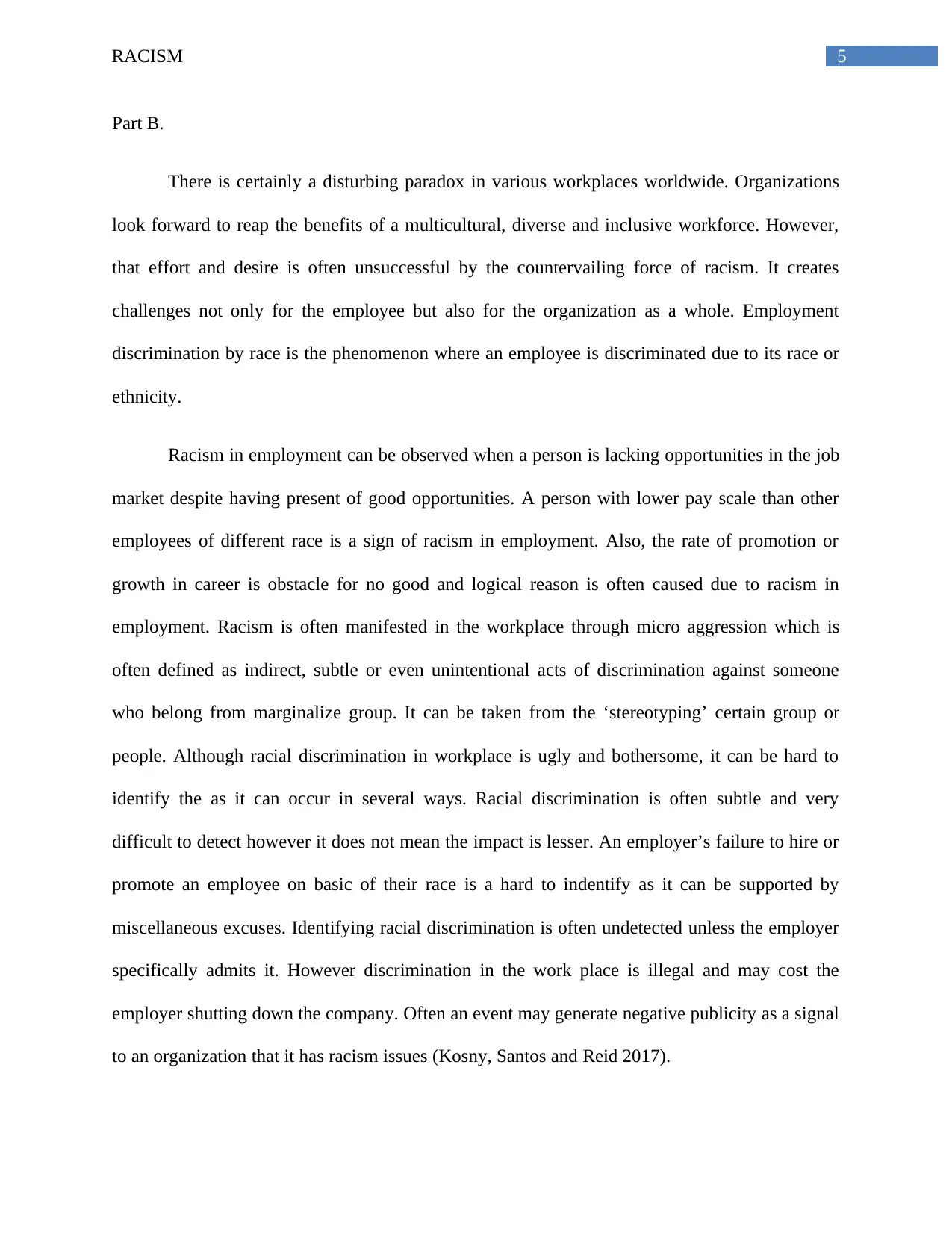
5RACISM
Part B.
There is certainly a disturbing paradox in various workplaces worldwide. Organizations
look forward to reap the benefits of a multicultural, diverse and inclusive workforce. However,
that effort and desire is often unsuccessful by the countervailing force of racism. It creates
challenges not only for the employee but also for the organization as a whole. Employment
discrimination by race is the phenomenon where an employee is discriminated due to its race or
ethnicity.
Racism in employment can be observed when a person is lacking opportunities in the job
market despite having present of good opportunities. A person with lower pay scale than other
employees of different race is a sign of racism in employment. Also, the rate of promotion or
growth in career is obstacle for no good and logical reason is often caused due to racism in
employment. Racism is often manifested in the workplace through micro aggression which is
often defined as indirect, subtle or even unintentional acts of discrimination against someone
who belong from marginalize group. It can be taken from the ‘stereotyping’ certain group or
people. Although racial discrimination in workplace is ugly and bothersome, it can be hard to
identify the as it can occur in several ways. Racial discrimination is often subtle and very
difficult to detect however it does not mean the impact is lesser. An employer’s failure to hire or
promote an employee on basic of their race is a hard to indentify as it can be supported by
miscellaneous excuses. Identifying racial discrimination is often undetected unless the employer
specifically admits it. However discrimination in the work place is illegal and may cost the
employer shutting down the company. Often an event may generate negative publicity as a signal
to an organization that it has racism issues (Kosny, Santos and Reid 2017).
Part B.
There is certainly a disturbing paradox in various workplaces worldwide. Organizations
look forward to reap the benefits of a multicultural, diverse and inclusive workforce. However,
that effort and desire is often unsuccessful by the countervailing force of racism. It creates
challenges not only for the employee but also for the organization as a whole. Employment
discrimination by race is the phenomenon where an employee is discriminated due to its race or
ethnicity.
Racism in employment can be observed when a person is lacking opportunities in the job
market despite having present of good opportunities. A person with lower pay scale than other
employees of different race is a sign of racism in employment. Also, the rate of promotion or
growth in career is obstacle for no good and logical reason is often caused due to racism in
employment. Racism is often manifested in the workplace through micro aggression which is
often defined as indirect, subtle or even unintentional acts of discrimination against someone
who belong from marginalize group. It can be taken from the ‘stereotyping’ certain group or
people. Although racial discrimination in workplace is ugly and bothersome, it can be hard to
identify the as it can occur in several ways. Racial discrimination is often subtle and very
difficult to detect however it does not mean the impact is lesser. An employer’s failure to hire or
promote an employee on basic of their race is a hard to indentify as it can be supported by
miscellaneous excuses. Identifying racial discrimination is often undetected unless the employer
specifically admits it. However discrimination in the work place is illegal and may cost the
employer shutting down the company. Often an event may generate negative publicity as a signal
to an organization that it has racism issues (Kosny, Santos and Reid 2017).
⊘ This is a preview!⊘
Do you want full access?
Subscribe today to unlock all pages.

Trusted by 1+ million students worldwide
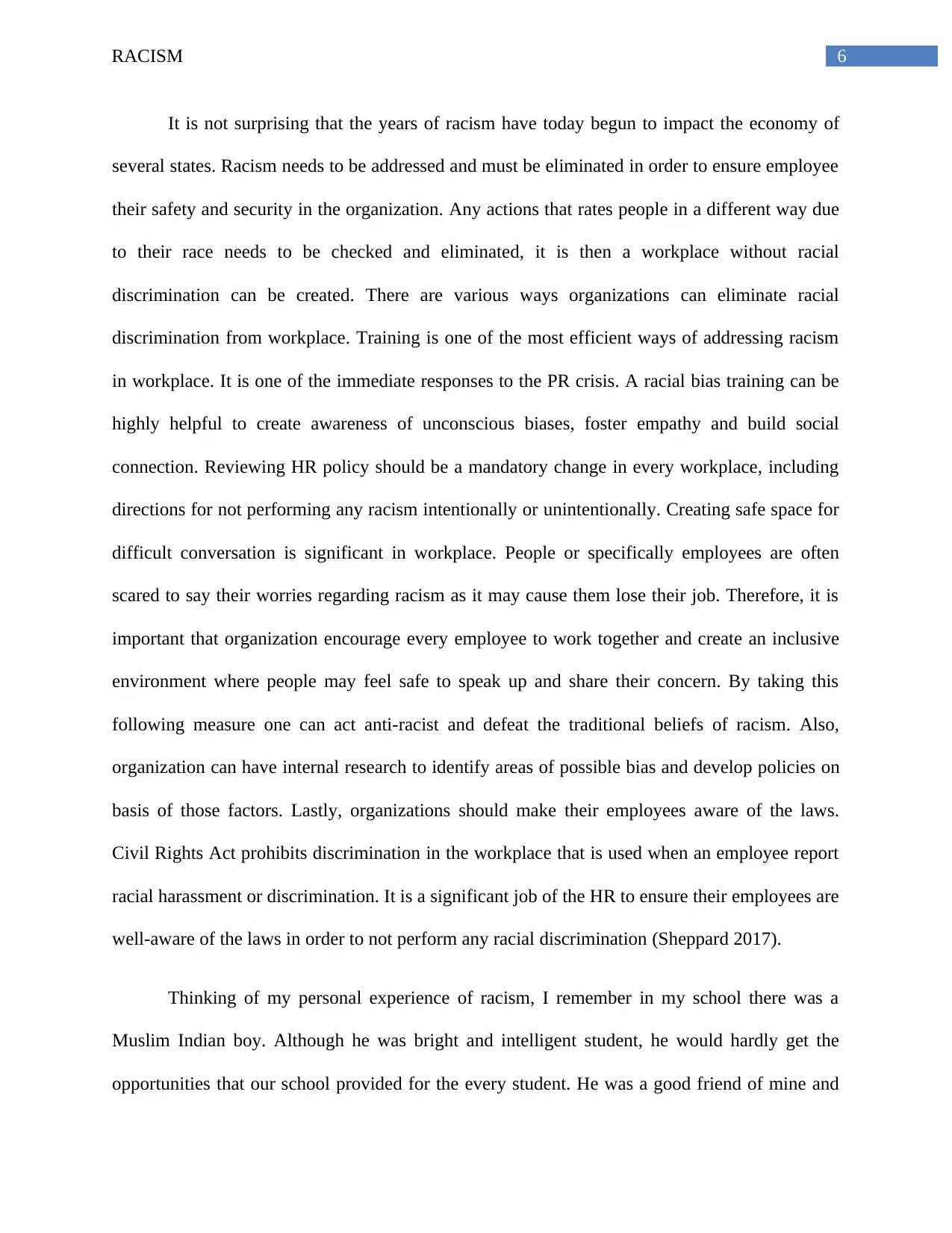
6RACISM
It is not surprising that the years of racism have today begun to impact the economy of
several states. Racism needs to be addressed and must be eliminated in order to ensure employee
their safety and security in the organization. Any actions that rates people in a different way due
to their race needs to be checked and eliminated, it is then a workplace without racial
discrimination can be created. There are various ways organizations can eliminate racial
discrimination from workplace. Training is one of the most efficient ways of addressing racism
in workplace. It is one of the immediate responses to the PR crisis. A racial bias training can be
highly helpful to create awareness of unconscious biases, foster empathy and build social
connection. Reviewing HR policy should be a mandatory change in every workplace, including
directions for not performing any racism intentionally or unintentionally. Creating safe space for
difficult conversation is significant in workplace. People or specifically employees are often
scared to say their worries regarding racism as it may cause them lose their job. Therefore, it is
important that organization encourage every employee to work together and create an inclusive
environment where people may feel safe to speak up and share their concern. By taking this
following measure one can act anti-racist and defeat the traditional beliefs of racism. Also,
organization can have internal research to identify areas of possible bias and develop policies on
basis of those factors. Lastly, organizations should make their employees aware of the laws.
Civil Rights Act prohibits discrimination in the workplace that is used when an employee report
racial harassment or discrimination. It is a significant job of the HR to ensure their employees are
well-aware of the laws in order to not perform any racial discrimination (Sheppard 2017).
Thinking of my personal experience of racism, I remember in my school there was a
Muslim Indian boy. Although he was bright and intelligent student, he would hardly get the
opportunities that our school provided for the every student. He was a good friend of mine and
It is not surprising that the years of racism have today begun to impact the economy of
several states. Racism needs to be addressed and must be eliminated in order to ensure employee
their safety and security in the organization. Any actions that rates people in a different way due
to their race needs to be checked and eliminated, it is then a workplace without racial
discrimination can be created. There are various ways organizations can eliminate racial
discrimination from workplace. Training is one of the most efficient ways of addressing racism
in workplace. It is one of the immediate responses to the PR crisis. A racial bias training can be
highly helpful to create awareness of unconscious biases, foster empathy and build social
connection. Reviewing HR policy should be a mandatory change in every workplace, including
directions for not performing any racism intentionally or unintentionally. Creating safe space for
difficult conversation is significant in workplace. People or specifically employees are often
scared to say their worries regarding racism as it may cause them lose their job. Therefore, it is
important that organization encourage every employee to work together and create an inclusive
environment where people may feel safe to speak up and share their concern. By taking this
following measure one can act anti-racist and defeat the traditional beliefs of racism. Also,
organization can have internal research to identify areas of possible bias and develop policies on
basis of those factors. Lastly, organizations should make their employees aware of the laws.
Civil Rights Act prohibits discrimination in the workplace that is used when an employee report
racial harassment or discrimination. It is a significant job of the HR to ensure their employees are
well-aware of the laws in order to not perform any racial discrimination (Sheppard 2017).
Thinking of my personal experience of racism, I remember in my school there was a
Muslim Indian boy. Although he was bright and intelligent student, he would hardly get the
opportunities that our school provided for the every student. He was a good friend of mine and
Paraphrase This Document
Need a fresh take? Get an instant paraphrase of this document with our AI Paraphraser
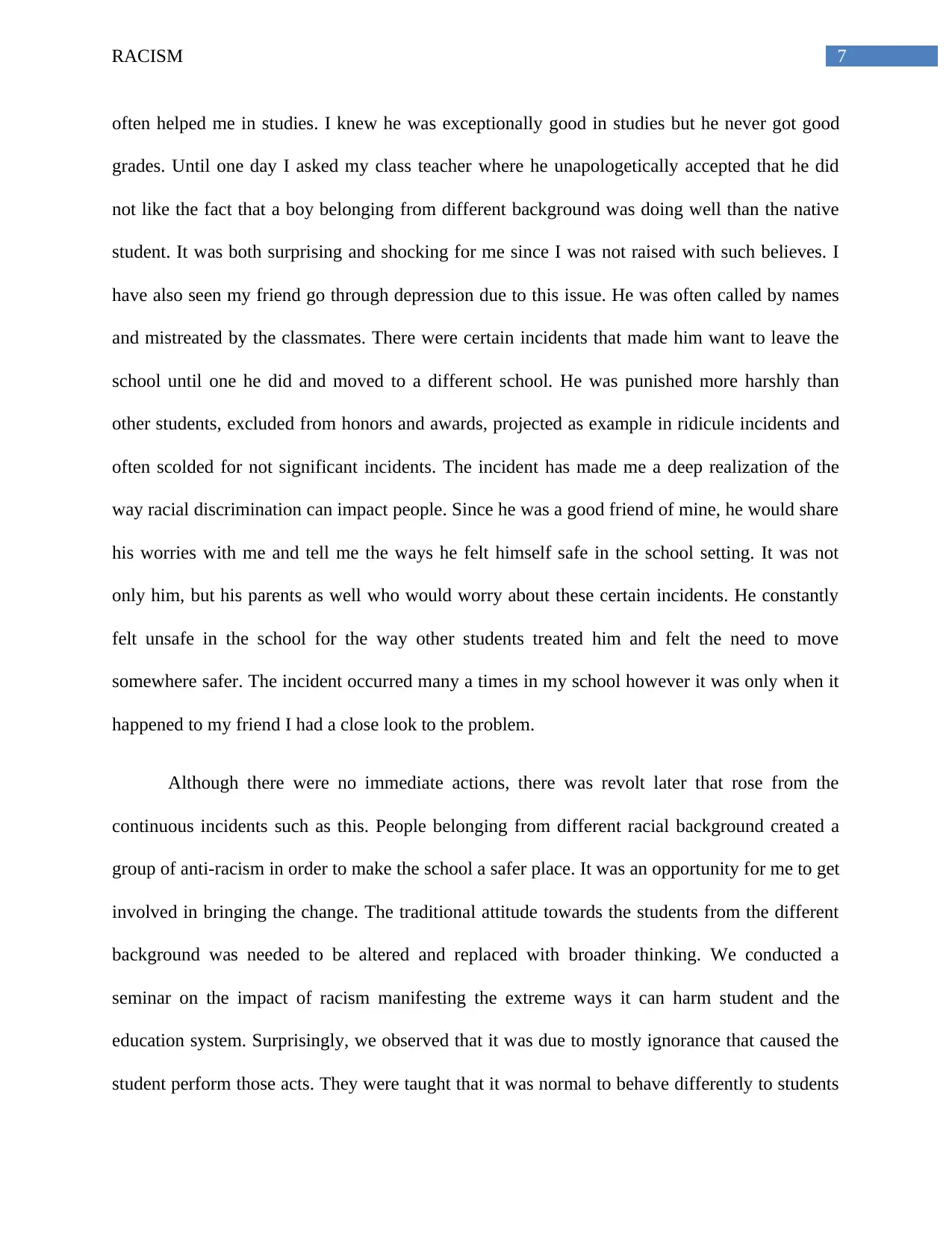
7RACISM
often helped me in studies. I knew he was exceptionally good in studies but he never got good
grades. Until one day I asked my class teacher where he unapologetically accepted that he did
not like the fact that a boy belonging from different background was doing well than the native
student. It was both surprising and shocking for me since I was not raised with such believes. I
have also seen my friend go through depression due to this issue. He was often called by names
and mistreated by the classmates. There were certain incidents that made him want to leave the
school until one he did and moved to a different school. He was punished more harshly than
other students, excluded from honors and awards, projected as example in ridicule incidents and
often scolded for not significant incidents. The incident has made me a deep realization of the
way racial discrimination can impact people. Since he was a good friend of mine, he would share
his worries with me and tell me the ways he felt himself safe in the school setting. It was not
only him, but his parents as well who would worry about these certain incidents. He constantly
felt unsafe in the school for the way other students treated him and felt the need to move
somewhere safer. The incident occurred many a times in my school however it was only when it
happened to my friend I had a close look to the problem.
Although there were no immediate actions, there was revolt later that rose from the
continuous incidents such as this. People belonging from different racial background created a
group of anti-racism in order to make the school a safer place. It was an opportunity for me to get
involved in bringing the change. The traditional attitude towards the students from the different
background was needed to be altered and replaced with broader thinking. We conducted a
seminar on the impact of racism manifesting the extreme ways it can harm student and the
education system. Surprisingly, we observed that it was due to mostly ignorance that caused the
student perform those acts. They were taught that it was normal to behave differently to students
often helped me in studies. I knew he was exceptionally good in studies but he never got good
grades. Until one day I asked my class teacher where he unapologetically accepted that he did
not like the fact that a boy belonging from different background was doing well than the native
student. It was both surprising and shocking for me since I was not raised with such believes. I
have also seen my friend go through depression due to this issue. He was often called by names
and mistreated by the classmates. There were certain incidents that made him want to leave the
school until one he did and moved to a different school. He was punished more harshly than
other students, excluded from honors and awards, projected as example in ridicule incidents and
often scolded for not significant incidents. The incident has made me a deep realization of the
way racial discrimination can impact people. Since he was a good friend of mine, he would share
his worries with me and tell me the ways he felt himself safe in the school setting. It was not
only him, but his parents as well who would worry about these certain incidents. He constantly
felt unsafe in the school for the way other students treated him and felt the need to move
somewhere safer. The incident occurred many a times in my school however it was only when it
happened to my friend I had a close look to the problem.
Although there were no immediate actions, there was revolt later that rose from the
continuous incidents such as this. People belonging from different racial background created a
group of anti-racism in order to make the school a safer place. It was an opportunity for me to get
involved in bringing the change. The traditional attitude towards the students from the different
background was needed to be altered and replaced with broader thinking. We conducted a
seminar on the impact of racism manifesting the extreme ways it can harm student and the
education system. Surprisingly, we observed that it was due to mostly ignorance that caused the
student perform those acts. They were taught that it was normal to behave differently to students
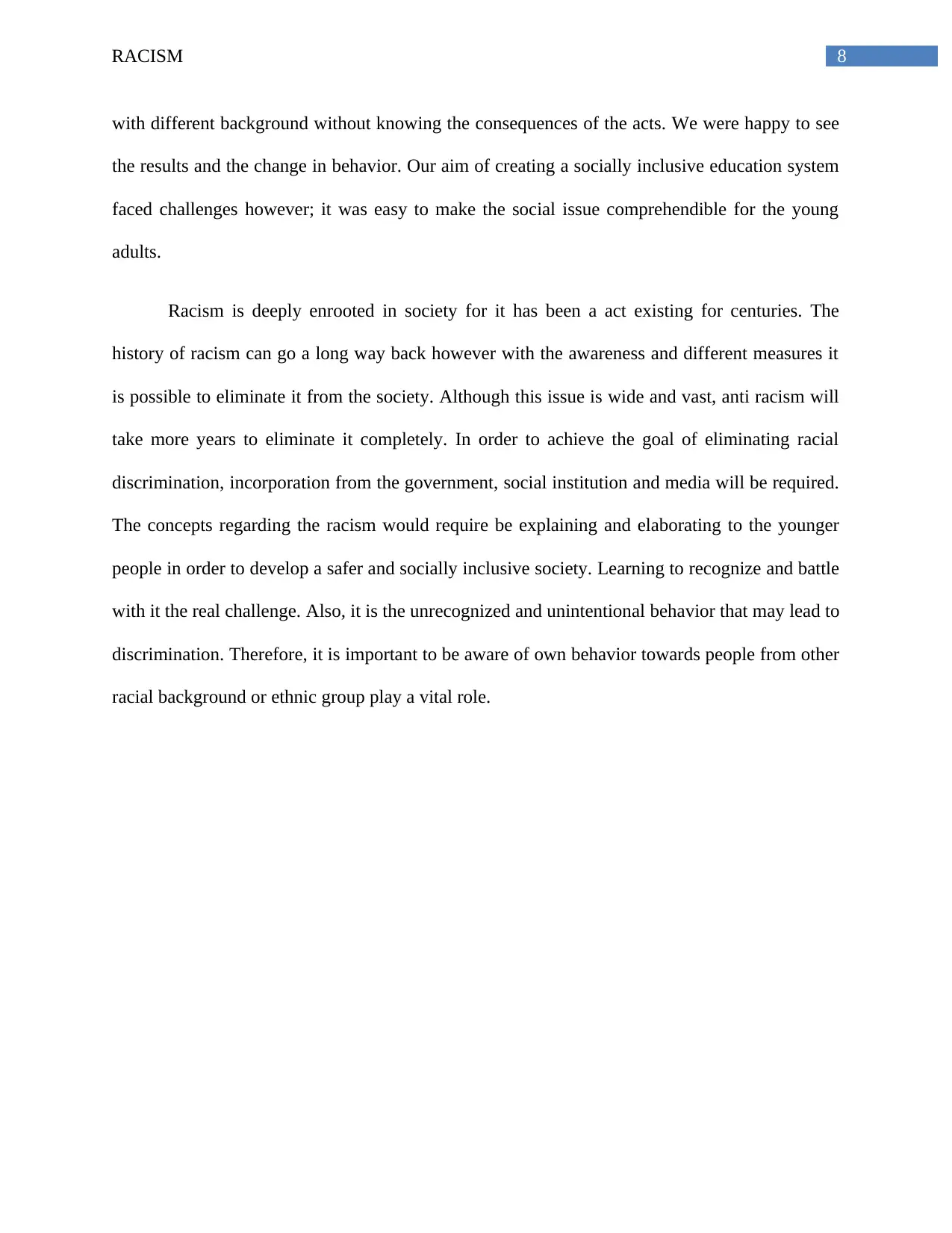
8RACISM
with different background without knowing the consequences of the acts. We were happy to see
the results and the change in behavior. Our aim of creating a socially inclusive education system
faced challenges however; it was easy to make the social issue comprehendible for the young
adults.
Racism is deeply enrooted in society for it has been a act existing for centuries. The
history of racism can go a long way back however with the awareness and different measures it
is possible to eliminate it from the society. Although this issue is wide and vast, anti racism will
take more years to eliminate it completely. In order to achieve the goal of eliminating racial
discrimination, incorporation from the government, social institution and media will be required.
The concepts regarding the racism would require be explaining and elaborating to the younger
people in order to develop a safer and socially inclusive society. Learning to recognize and battle
with it the real challenge. Also, it is the unrecognized and unintentional behavior that may lead to
discrimination. Therefore, it is important to be aware of own behavior towards people from other
racial background or ethnic group play a vital role.
with different background without knowing the consequences of the acts. We were happy to see
the results and the change in behavior. Our aim of creating a socially inclusive education system
faced challenges however; it was easy to make the social issue comprehendible for the young
adults.
Racism is deeply enrooted in society for it has been a act existing for centuries. The
history of racism can go a long way back however with the awareness and different measures it
is possible to eliminate it from the society. Although this issue is wide and vast, anti racism will
take more years to eliminate it completely. In order to achieve the goal of eliminating racial
discrimination, incorporation from the government, social institution and media will be required.
The concepts regarding the racism would require be explaining and elaborating to the younger
people in order to develop a safer and socially inclusive society. Learning to recognize and battle
with it the real challenge. Also, it is the unrecognized and unintentional behavior that may lead to
discrimination. Therefore, it is important to be aware of own behavior towards people from other
racial background or ethnic group play a vital role.
⊘ This is a preview!⊘
Do you want full access?
Subscribe today to unlock all pages.

Trusted by 1+ million students worldwide

9RACISM
References:
Abramovitz, M. and Blitz, L.V., 2015. Moving toward racial equity: The undoing racism
workshop and organizational change. Race and Social Problems, 7(2), pp.97-110.
Chavez-Dueñas, N.Y., Adames, H.Y. and Organista, K.C., 2014. Skin-color prejudice and
within-group racial discrimination: Historical and current impact on Latino/a
populations. Hispanic Journal of Behavioral Sciences, 36(1), pp.3-26.
Crenshaw, K., 2018. Demarginalizing the intersection of race and sex: A Black feminist critique
of antidiscrimination doctrine, feminist theory, and antiracist politics [1989]. In Feminist legal
theory (pp. 57-80). Routledge.
Haavisto, C., 2019. The Power of Being Heard: How Claims Against Racism Are Constructed,
Spread, and Listened to in a Hybrid Media Environment. In Racialization, Racism, and Anti-
Racism in the Nordic Countries (pp. 229-262). Palgrave Macmillan, Cham.
Healey, J.F., Stepnick, A. and O'Brien, E., 2018. Race, ethnicity, gender, and class: The
sociology of group conflict and change. Sage Publications.
Hernández, E., 2016. Utilizing critical race theory to examine race/ethnicity, racism, and power
in student development theory and research. Journal of College Student Development, 57(2),
pp.168-180.
Hess, J., 2015. Upping the “anti-”: The value of an anti-racist theoretical framework in music
education. Action, Criticism, and Theory for Music Education, 14(1), pp.66-92.
Johnstone, R.L., 2015. Religion in society: A sociology of religion. Routledge.
References:
Abramovitz, M. and Blitz, L.V., 2015. Moving toward racial equity: The undoing racism
workshop and organizational change. Race and Social Problems, 7(2), pp.97-110.
Chavez-Dueñas, N.Y., Adames, H.Y. and Organista, K.C., 2014. Skin-color prejudice and
within-group racial discrimination: Historical and current impact on Latino/a
populations. Hispanic Journal of Behavioral Sciences, 36(1), pp.3-26.
Crenshaw, K., 2018. Demarginalizing the intersection of race and sex: A Black feminist critique
of antidiscrimination doctrine, feminist theory, and antiracist politics [1989]. In Feminist legal
theory (pp. 57-80). Routledge.
Haavisto, C., 2019. The Power of Being Heard: How Claims Against Racism Are Constructed,
Spread, and Listened to in a Hybrid Media Environment. In Racialization, Racism, and Anti-
Racism in the Nordic Countries (pp. 229-262). Palgrave Macmillan, Cham.
Healey, J.F., Stepnick, A. and O'Brien, E., 2018. Race, ethnicity, gender, and class: The
sociology of group conflict and change. Sage Publications.
Hernández, E., 2016. Utilizing critical race theory to examine race/ethnicity, racism, and power
in student development theory and research. Journal of College Student Development, 57(2),
pp.168-180.
Hess, J., 2015. Upping the “anti-”: The value of an anti-racist theoretical framework in music
education. Action, Criticism, and Theory for Music Education, 14(1), pp.66-92.
Johnstone, R.L., 2015. Religion in society: A sociology of religion. Routledge.
Paraphrase This Document
Need a fresh take? Get an instant paraphrase of this document with our AI Paraphraser
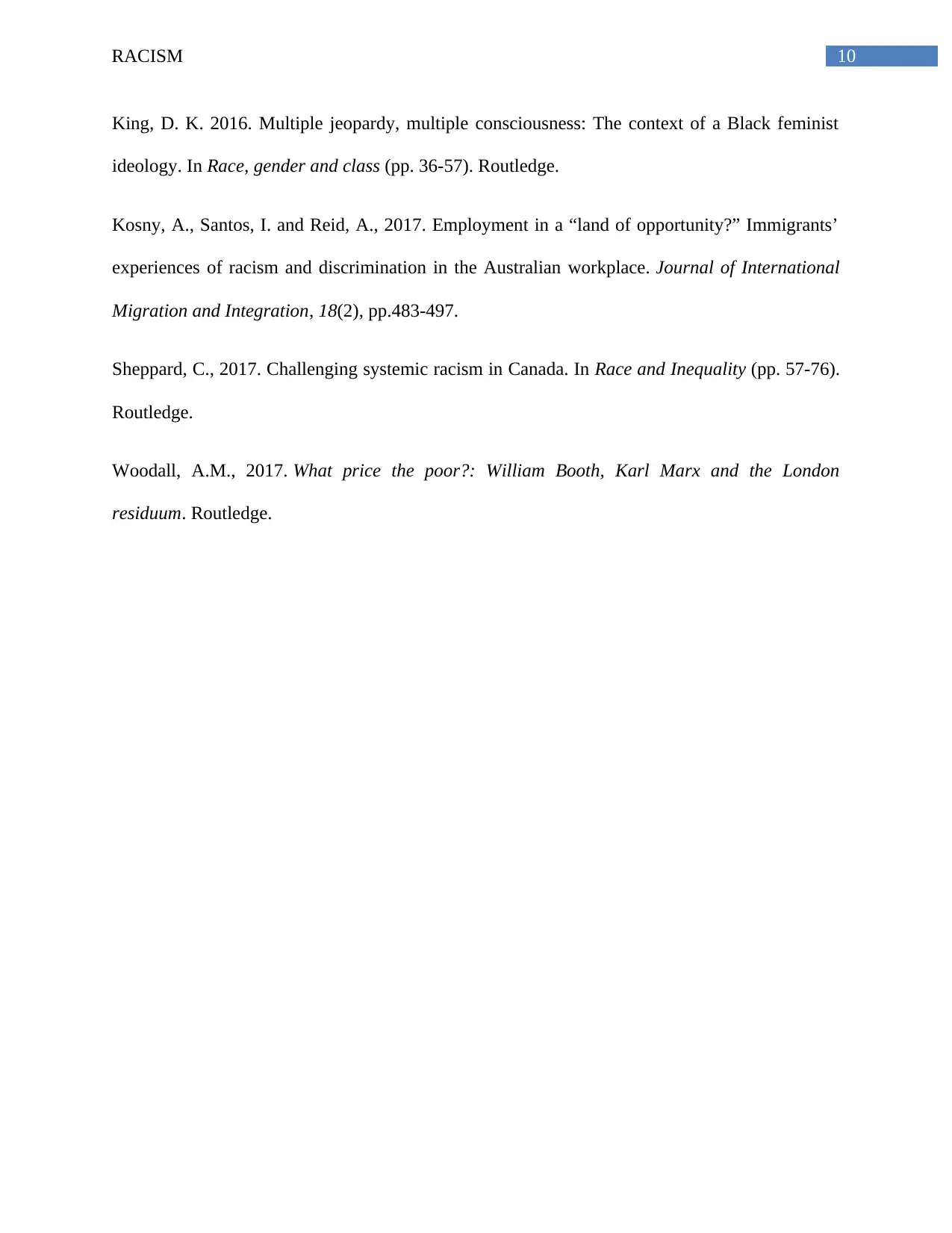
10RACISM
King, D. K. 2016. Multiple jeopardy, multiple consciousness: The context of a Black feminist
ideology. In Race, gender and class (pp. 36-57). Routledge.
Kosny, A., Santos, I. and Reid, A., 2017. Employment in a “land of opportunity?” Immigrants’
experiences of racism and discrimination in the Australian workplace. Journal of International
Migration and Integration, 18(2), pp.483-497.
Sheppard, C., 2017. Challenging systemic racism in Canada. In Race and Inequality (pp. 57-76).
Routledge.
Woodall, A.M., 2017. What price the poor?: William Booth, Karl Marx and the London
residuum. Routledge.
King, D. K. 2016. Multiple jeopardy, multiple consciousness: The context of a Black feminist
ideology. In Race, gender and class (pp. 36-57). Routledge.
Kosny, A., Santos, I. and Reid, A., 2017. Employment in a “land of opportunity?” Immigrants’
experiences of racism and discrimination in the Australian workplace. Journal of International
Migration and Integration, 18(2), pp.483-497.
Sheppard, C., 2017. Challenging systemic racism in Canada. In Race and Inequality (pp. 57-76).
Routledge.
Woodall, A.M., 2017. What price the poor?: William Booth, Karl Marx and the London
residuum. Routledge.
1 out of 11
Related Documents
Your All-in-One AI-Powered Toolkit for Academic Success.
+13062052269
info@desklib.com
Available 24*7 on WhatsApp / Email
![[object Object]](/_next/static/media/star-bottom.7253800d.svg)
Unlock your academic potential
Copyright © 2020–2025 A2Z Services. All Rights Reserved. Developed and managed by ZUCOL.





